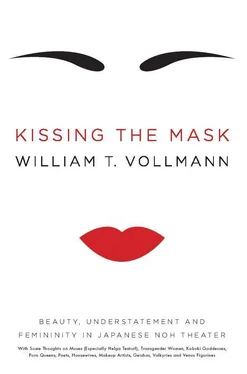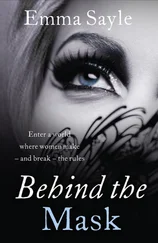The words, music and choreography of a Noh drama cannot be changed. 17The role is eternal. The mask is, practically speaking, nearly eternal: longer than a single human life. (Asked how long his collection would last, Mr. Umewaka very characteristically replied: “That is the concern. The new ones are weaker.” Mr. Otsuka hoped and expected for his masks a minimum useful life of one hundred fifty to three hundred years.) In a catalogue of selected masks from the Kanze School, which was made the official style of the Tokugawa Shogunate and to which the Umewaka family belongs (there are five schools of Noh, 18and, just as you might imagine, it can be difficult to tell them apart), we find these captions: seventeenth century, sixteenth century, fifteenth century, eighteenth century… This ko-omote mask which Mr. Umewaka’s apprentice has now unboxed for me might well have kept its virginity for four or five centuries. And five centuries from now, Noh may still be performed. In my discussion with the Noh actress Yamamura Yoko, when I brought up the melancholy fact that Shakespeare’s language grows less intelligible to each English-speaking generation, she agreed that Noh suffers from the same wasting-sickness, but “the story itself is always simple, so it could happen in any age or country: a love affair, or sin, or conflict between parent and child.” In effect, she thought that as long as we remain human (which, come to think of it, may not be much longer), Noh would live, and therefore so would this sixteen-year-old girl of the ko-omote , I mean this mask, this scratched wooden object whose paint has begun to scale and whose faceless side is salted with the sweat of many dead men.
In comparison to her older waka-onna sister, the ko-omote ’s cheeks are plumper; in fact, the face actually widens toward the chin. The mask which Mr. Umewaka prefers for the warrior Atsumori, who like Kagekiyo fought against the Genji but came to a different end — slain at age fifteen — resembles hers in its high-eyebrowed, 19pallid delicacy, but like the waka-onna it tapers at the chin; it’s more spade-shaped. (Some performers do in fact play Atsumori with a female mask. Hide the eyebrows with a white sweatband, and you’ve indicated preparation for war.) The story is typically Noh: Atsumori’s killer, having overcome his pity and decapitated the boy, discovers a bamboo flute upon the corpse. This revelation of an artistic spirit makes him so remorseful that he becomes a priest in order to pray for Atsumori’s soul — assistance which the victim surely needs, being under the same statutory damnation as Kagekiyo. At the end the antagonists are reconciled. Knowing this story, one looks upon the vulnerable, almost effeminate beauty of the Atsumori mask with new eyes. Effeminate, yes, but not female. How subtle these masks are! And this subtlety, like all great art, creates its own world which, like the world of nature, we need to survey from one fixed perspective but can walk around in, discovering ever finer details, as if we were to admire the beauty of a fern first by approaching and touching it, then by viewing it through a hand lens, and finally by using a microscope to observe its cellular organization. 20To many people, such a minuscule appreciation is pedantry. Let them think so. I know that I will never tire of gazing at Noh masks.
The particular ko-omote which I have been describing is used in Mr. Umewaka’s theater to play the beautiful young ghost in “Izutsu” — no matter that she is actually of waka-onna age; “our school does this because we have the original mask,” said the other apprentice. This drama, written nearly six centuries ago and still frequently performed, expresses the same sadness about the transitory nature of life as “Kagekiyo,” although the latter story was about valor-attachment and this one deals with love-attachment: “A frail dream breaks awake; the dream breaks to dawn.” This mask is a frail dream, to be sure; it crowns a brocade kimono with a man inside it. And now the apprentice has laid it face up on the floor.
As I bend down toward it, my eyes not yet at chin level, it begins by looking upward and through me. How alive it truly is! The mask-carver in Yokohama had said: “When I feel some existence in them, I’m happy.” If I were this girl’s lover, my head would now be level with her breast. At this angle, the pallid, surprised beauty of her face, fit company for the slick, smooth-lacquered feel of the mask, seems wrapped up in itself; by classical standards she has already become a woman; 21she lives in the narcissism of her fresh new beauty. I draw almost even with her face, and the expression becomes more intense, more aware of me, almost lustful; and then, when my face is right over hers, as if to kiss her, she gazes straight up into my eyes. I go on past; she looks up at me and is smiling.
BECOMING OKINA
“The mask is most important always ,” Mr. Umewaka kept reminding me, which is why I will tell you whatever I can about the masks; but my best efforts can help you envision the living mask about as much as my descriptions of each instrument in the orchestra could help you hear Beethoven’s Ninth. When the mask comes alive, one feels awe. Yamamura Yoko said of him: “The air of the stage changes when he comes! The ki, the energy that goes through your body, in his case, if he extends his arm, the ki goes beyond his arm.” How can I convey to you the sense of an actual Noh performance? Even if I knew the Japanese language (and anyhow most Japanese cannot understand Noh’s words when they are chanted, just as Germans cannot parse the syllables which the Wagner soprano sings); even if I possessed a connoisseur’s knowledge, which I never shall, to relate to you what happened from start to finish one evening on that Noh stage with its triple-pine-tree’d bridge and the painted pine tree on the mirror-board, I’d be forced to rely on footnotes, parentheses, destructive translations. And since I’m not capable of executing that bad compromise, I’ll fall back on relating what I see and hear — actually, I don’t know how to describe what I hear; please imagine for yourself the chorus’s kneeling ranks and crested kimonos, their profiles as they gaze into the nothingness beyond the rainbow curtain. “It’s all drums, mostly,” explained Mr. Umewaka. “As for the voices, they should make you feel the situation. This is very simple, and so very difficult. How much emotion can they express? That’s the key.” On another occasion he advised me that melody is less significant a factor than harmony. Enough said. Here then is vision without much reference to sound: Mr. Umewaka appears in a female mask for “Takasago,” which celebrates the matrimonial harmony of two pine trees; he wears a purple kimono with golden chrysanthemums inset in triply nested hexagons; he stamps while the drummers wail like wolves. 22The way his sleeves can suddenly swivel out and backward lies beyond words; but that is because Noh itself, as I keep repeating, lies beyond reality. Be that as it may, I’ll do my best. Perhaps I won’t completely fail; we need not all be botanists to describe a jungle’s foliage. So please allow me to bring you into the almost unconsciously integrated, techno-coral-reef ambiance of twenty-first-century Japan, which allows one to walk out of a hotel lobby and immediately find oneself upon a transparent covered bridge which leads directly to a train station attended by tiny, perfect restaurants and bookstores; one changes trains, exits into the swarm of the hub station, buys another ticket on another line, rides one stop, passes through the turnstile, ascends a flight of steps, passes down a corridor of many restaurants, takes another flight of steps to another hotel lobby, and the third flight of steps brings one right to Osaka’s spacious Festival Hall where well-dressed Noh-goers now fan themselves in the anteroom behind sparkling glass doors, waiting for the metal grating to rise, which when it does will reveal first four pairs of shiny high heels, then four pairs of slender ankles, pretty legs, and in good time four burgundy miniskirts, four pairs of hands clasped across four uniformed abdomens, four smiles; these ladies accept our tickets and the crowd pours into the bright red velvet seats which resemble rows of lipstick-stained teeth. Before us lies a modernist Noh stage like a squarish, squat-handled axe upon a blackness which is organ-piped with silvery-golden floral decorations created by a leading ikebana designer. Mr. Umewaka, who likes the unrehearsed spontaneity of present-day Noh now that the ancient troupes have relaxed their strictures against exogamy (“this way it is more interesting,” he says), and who calls Mishima’s modernist Noh plays the best of their kind, 23who has tried to create “new Noh,” and is now considering collaborating in a Noh drama about the Minamata mercury spill, has given me to understand that the staging here at Osaka is a little too much. The third play of the evening will be “Yuya,” about a Heike lord’s concubine who longs for permission to visit her dying mother. At first the lord refuses. Desiring so greatly to kiss her mask, he commands her to accompany him to the cherry blossom viewing; he suffers, perhaps, from a presentiment of the Heike’s oncoming doom, which is ours; but in the end, she writes a poem likening her mother to a cherry-blossom, and wins his consent to depart. In a traditional Noh performance, the pallidly beautiful doll-mask of Yuya’s face and her orange brocade would suffice; she’s sexual and silent, receptively, untouchably divine, statue and girl; and when the news of her mother’s illness arrives, she kneels before her lord, imparting to us a feeling somehow sweet and cloudy, like the sake of the Edo period; and her mask bows exactly enough for its fixed lips to part in smiling grief; her face shines rapt over the letter of tidings which she sings in her deep man’s voice. This is Noh: a doll-mask face weeping invisible tears, half covering itself with a brawny old hand in order to telegraph its weeping. All these elements remain present, but the ikebana modernist has added cherry blossoms and bamboo trellises; the lighting changes; the sky glows blue; it’s all quite gorgeous, although it may not be Noh; it demonstrates why Noh is not in fact opera. One aficionado, a stewardess who’s attended fifty of Mr. Umewaka’s performances thus far, contemptuously refers to the cherry blossoms as “noisy” ( urusai ), and this is before Yuya’s dance, when from above a myriad of shockingly literal blossoms come drifting down. My interpreter, Takako, who is so contemporary in every respect that she often finds Noh to be quite boring, later said to me, “If there had been one or two flowers, all right, that might have been nice; that would have made the point. But didn’t you think that this was too much?” In fact I was enough of a barbarian to enjoy the flower-rain; I’m my parents’ son; they were thrilled to see a performance of “Aida” with live elephants. Hardly Mr. Umewaka’s cup of tea! 24And he will not perform in this version of “Yuya”; in fact; he will not stay to watch it.
Читать дальше












